(DIS)PLACED: Philadelphia | Expressions of Identity in Transition
See videos and photos of eL Seed’s residency
Written by Ann de Forest
Day One
eL Seed in Conversations with the Community | November 11, 2017
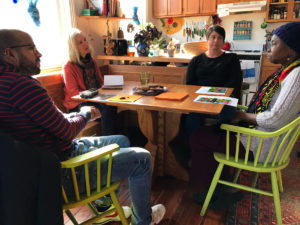
el Seed arrives jet-lagged, fighting a cold, and shocked by the sub-freezing temperatures, which have shocked every living thing in Philadelphia, including the unseasonably green trees that dropped their leaves overnight. Two days ago, he was in Korea, painting a mural on the top of the fence that marks the DMZ between South and North. On Saturday morning, he sits in Tara O’Brien’s sunny second floor kitchen on North 40th Street eating a homemade molasses cookie and listening to Tara and her next door neighbor Tatelin El talk about the changes they’ve seen in their neighborhood. Just that week, they won a hard-fought zoning battle against an absentee landlord who wanted to convert three small lots on the narrow street behind their houses into a single parcel so he could build a multi-unit apartment building.
Downstairs, in Tara’s studio, the two artists talk technique. One of her delicate hand-crafted books unfolds to reveal a striking panorama of fruit trees from Tara’s native California, wild mustard blooming below the pale trunks. Each tree trunk glitters with hand-stitched gold thread, and tiny copper-colored pearls dangle from the net of slender threads. The pearls represent mustard seeds, Tara says, referring to the New Testament parable of the mustard seed “…which a man took and threw into his own garden; and it grew and became a tree, and the birds of the air nested in its branches.”
****
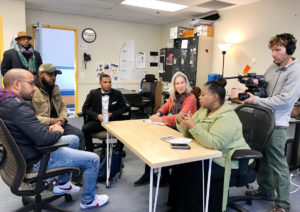
People’s Emergency Center, eL Seed’s next stop on his itinerary of neighborhood visits, brings that parable to life. A neighborhood presence for 45 years, PEC began as a shelter for women and children fleeing domestic violence. Now, as Cass Green, Manager of Community Outreach and Partnerships, tells eL Seed, they are community catalysts, developing affordable housing, offering job training and after school programs, and responding to the wide range of community needs. “Our goal,” she says, “is to keep people in the community. We want to maintain the housing stock so that people can live, have equity, and thrive.” eL Seed absorbs her words. “I try to create bridges between my culture and Philadelphia’s culture… If you link with the community, then the community will see something on the wall and know what it is and where it came from. They will link with the piece.”
****
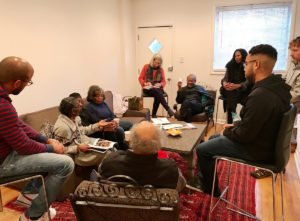
In the late afternoon, neighbors gather on “Little Filbert Street,” a cul de sac just off 42nd Street, where Pam Andrews and her husband John serve hearty soup and host a community conversation. “Mi casa es tu casa,” John welcomes their visitors. The discussion centers on change. Those gathered, all African American, range in age from Isabella Frasier, 85, to Adrian McCall, 35, who stops by for a brief visit. They reminisce about the past, both good – the liveliness of Market Street when “there was a bar on every corner, and a church on every block,” the excellence of the public school education they received and their caring, demanding teachers – and bad – segregation under Jim Crow, redlining, and the razing of the Black Bottom. Patricia Stewart Anderson, retired schoolteacher, laments today’s disinvestment in public institutions and cites the forces of what she calls GPC (Greed, Power, and Control).
Pam Andrews, a retired social worker and block captain, is determined to stand up to those forces. “Change is inevitable,” she says. “Things won’t go back to the way they are,” adds John. “People are very nervous, very skeptical about gentrification, because they see change happening to them, and not for them and by them.”
“I’ve always considered myself a change agent,” says Pam. “I bring people and groups together… You do what you can do. But you have to do something.”
Attention turns to eL Seed. What will he put on the wall? The neighbors are eager to know. “I had an idea,” he says, “and then today I had another idea. Now here, I have another… It will be a surprise.”
***
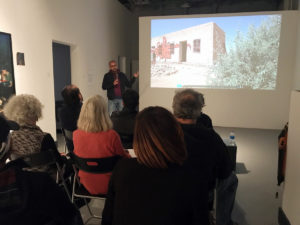
Later that evening, eL Seed addresses a social gathering at Slought Foundation. Images of past projects shine on a screen behind him. “My voice is a bit broken,” he says. “I’ve had a super-intense day.”
Day Two
The Power of Public Art | Sunday, November 12, 2017
Even before arriving in Philadelphia, eL Seed was intrigued by the city’s reputation as a hub for public art, especially murals. “I always wanted to come to Philadelphia,” he said in a phone message to Al-Bustan a week before his trip. “I’m a bit nervous because I know so many legends of mural art, street art and public art have gone through there.”
On his second full day in Philadelphia, eL Seed got to see some of those legendary murals on a tour led by Mural Arts Philadelphia. Meg Saligman’s Philadelphia Muses “blew me away,” he says, mimicking the languid pose of the dancer stretched out at the mural’s base. Impressed by the artist’s blend of photo-realistic detail with fantastic imagery, he was struck most of all by her technique. Spray paint is his medium, speedy and direct. Philadelphia Muses, at 13th and Locust Streets, was “all painted by brush,” he says with awe.
***
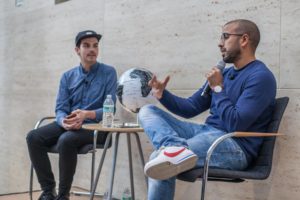
In the afternoon, eL Seed recounts his first impressions of Philadelphia, its murals, its street art, and its people to blogger Conrad Benner in a public conversation at University of Pennsylvania’s Perry World House. “What drove you to do art in public spaces?” Benner asks. eL Seed tells about his early work as a graffiti artist. “I used to go to old broken buildings,” he says, and the art he made there “was only available in pictures.” When he began choosing more public sites, he enjoyed the human interaction. Painting in public attracted spectators and generated conversation. Now, as he travels the world, from Korea to Cairo to the favelas of Brazil, the deserts of Tunisia, a bridge over the Seine, and the banks of the Rhone in Lyons, he understands that those conversations are what change perceptions and inspire, he hopes, social change. Often he is the one most changed by his encounters with others.
“What I’m looking for,” he tells Benner, “is this human experience, and the mural is a pretext for gathering people… for generating interactions.” He shows a short film about the project that profoundly shifted his understanding of the world, his art, and his life, the months he spent among the Coptic community that collects and recycles garbage in the Zareeb district of Cairo, painting a mural that encompassed walls on 50 buildings.
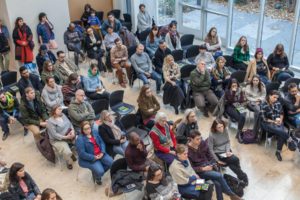
Asked about the theme of displacement, the focus of the Al-Bustan project that brings him to Philadelphia, eL Seed talks movingly of his own identity crisis when he was 16. The child of Tunisian immigrants in Paris, he had reclaimed his Arab identity as a teenager, learning Arabic and teaching himself calligraphy in part to assert his roots. “I felt like I needed to choose between being French and being Tunisian,” he said. But he never felt at home in either place. “I look more like someone named Muhammad then someone named Jean-Claude,” he says. Yet when he visited family in Tunisia, he was considered too French.
***
Inspired by the conversation and the stunning images of eL Seed’s work around the world, Jane Golden, founder and executive director of Mural Arts Philadelphia, sets aside the notes she had prepared to conclude the afternoon and speaks from her heart. “Beauty is something that doesn’t belong to one person,” she says. “It is co-owned by everyone.” eL Seed’s work embodies the mission of Mural Arts. “I believe art is catalytic and powerful, and it has a profound impact,” she tells the audience. To eL Seed she adds, “Philly is the city that cares about art.”
Also see Penn student and Al-Bustan intern Anisa Hasan-Graneir’s personal reflection on eL Seed’s conversation with Conrad Benner.
Day Three
Shades of Grey | Monday, November 13, 2017
Morning
A cold, steady rain has pre-empted the morning’s scheduled start of eL Seed’s painting at the wall. Instead, eL Seed and two of the other artists-in-residence for Al-Bustan’s (DIS)PLACED project, poet Nazem El Sayed and composer Kinan Abou-afach, meet up for a conversation. In the grey ground floor classroom in West Philadelphia’s Community Education Center (a community arts center housed in a 19th century Quaker school), the poet, musician, and visual artist share their own experiences with displacement and talk about how those experiences have shaped their art and their projects for (DIS)PLACED.
Poet Nazem ElSayed was born at the start of the civil war in Lebanon, and spent his childhood moving from one place to another. Rootlessness and restlessness have informed his entire life, he says. Never having known a sense of permanence, he found it difficult to settle in a job, in a career, in a relationship.
Until he was 12, composer Kinan Abou-afach lived with his family in a tiny one-room house outside of Damascus. Though his family moved to a larger and nicer house, he returns to his memories of that tiny house whenever he thinks about the meaning of home.
eL Seed talks of his upbringing in a working class suburb of Paris. He was born to Tunisian immigrant parents in a neighborhood that centered around the sprawling Renault factory, where his father and most of his neighbors worked. The factory shut down in the 1990s, he says, taking its operations and its jobs south. Twenty years later, high-end residences and upscale shops have erased all evidence of the town’s manufacturing past. eL Seed left France to find work after college and now lives in Dubai. When he goes back, he does not recognize his old neighborhood. Nothing there resonates as home. “It’s a weird feeling,” he says. “Now, my home is in my shoes,” he says. “Home is wherever my shoes take me.”
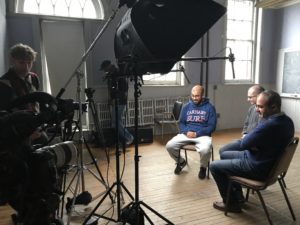
“Language to me is my home,” says Nazem. the linguistic displacement of living in the U.S. infused his poetry with a new, energetic tension. “I started anew in another language,” he says. He was always translating in order to understand and navigate daily life. He was immersed in a world of incomprehensible sounds, and he struggled to make sense. That dissociation reflected his own approach to poetry, writing in prose rather than the classic Arabic poetic form with rhyme and meter. The poems he is writing for (DIS)PLACED focus on ordinary experiences and everyday objects that have become, in his distance from them, odd and unsettling. The project’s theme of displacement, he tells the others, has given him a lens for understanding and expressing his own experiences.
In his musical compositions for (DIS)PLACED, Kinan says, he was drawn to the 12 individual stories of Philadelphians’ experiences with displacement, collected for the project. His first thought was to write a piece for each person, 12 musical expressions of the varied stories. But as he listened to the recorded interviews, he realized that every story shared a similar arc – departure, journey, and arrival. Those three experiences became the focus of his own compositions.
eL Seed’s work is focused on the displacement experienced in the West Powelton neighborhood where the mural will become a permanent, perhaps transformative, feature. This project is unusual, he told his fellow artists. Usually he arrives and just starts painting. Though he researched as much as he could of Philadelphia’s history and culture before he arrived, his two days listening to the people who lived in West Powelton shifted his initial thoughts. It was just last night that he found a quote by W.E.B. Du Bois that captured the spirit of the project, of Philadelphia, and of the African American community who live in West Powelton.
In 1899, “Du Bwa,” as eL Seed pronounces in the original French (“I don’t know why you say Du Bois,” he laughs) wrote the groundbreaking sociological study, The Philadelphia Negro, published by University of Pennsylvania Press in 1899. The quotation comes from a later, autobiographical book, Darkwater: Voices from Within the Veil, published in 1920. “Art not only transforms others, but it transforms you,” he says, and then reads the quote from his phone:
I believe that all men, black and brown and white, are brothers, varying through time and opportunity, in form and gift and feature, but differing in no essential particular, and alike in soul and the possibility of infinite development.
***
Afternoon
The rain has slowed to a drizzle. eL Seed is itching to get to work. The walls at Market and Preston Streets are waiting.
The blank horizontal wall, smeared with a thick impasto of anti-graffiti paint in two shades of grey, is itself a sign of displacement. A building once stood in that spot and shared that wall with the building beside it. Now, that rough-surface presides over a scruffy, trash-strewn lot, a scar of what was torn away, the last vestige of a place that had once had life and purpose.
The vertical brick wall next door to the vacant lot, on the other hand, is a survivor. eL Seed’s mural will actually cover two walls, with Du Bois’ quote translated into colorful, gestural Arabic calligraphy, repeated vertically and horizontally. The brick surface is the side wall of the former Bell Telephone Exchange Building, a national historic landmark, recently bought by a local developer who is renovating it to become an office rental space.
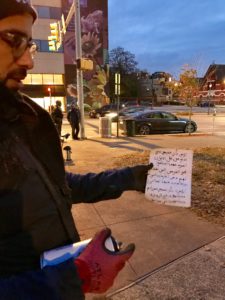
A boom lift beep beep beeps as it pulls out of the orange mud. eL Seed and mural arts assistant Malachi ride to the top of the high red brick wall and practice maneuvering the lift and platform up and down, side by side. eL Seed glances at a piece of paper on which is written the Arabic translation of du Bois’ uplifting words. He shakes and opens a can of black spray paint and waves his hands over the brick. Lacy outlines of letters start to form.
Across the street, a man in a heavy jacket and knit Eagles cap stands watching the process. He clutches a sheaf of papers he wants to share with the project team. Kernard Shearlds, 67, is a proud lifelong resident of the neighborhood, the surviving remnant of the Black Bottom, which once extended from 36th to 43rd Streets and from Walnut Street to Lancaster Avenue. The University of Pennsylvania razed the eastern half of the Bottom in the 1960s by “eminent domain” and built the University City Science Center.
Kernard points up Market to where his father had a barber shop. Kernard, who still lives in the family home on Preston Street, animates the street with his memories. His photocopies show side-by-side views of intersections of 40th and Market, from 1964 and 2004. The early shots show streets packed with pedestrians, both black and white, storefronts, bars, and movie theaters. 50 years later, many of the buildings have disappeared, shops and theaters have been replaced with furniture stores and modern low-rises, and the sidewalks are far less dense with people.
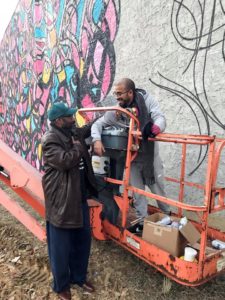
Kernard wants eL Seed to know about the history of the Black Bottom, the pride and the pain that old-timers like him still feel. He hopes that somehow eL Seed’s mural will honor that neighborhood’s vibrant past.
He mentions the building that was torn down. He remembers when it was a bar, with a back door entrance. He points, describing the layout, then laughs when he notices the two slabs of granite lying in the weeds and mud. “The remaining back steps…” he says. “That was the spot where my friends and I would sneak a little libation.”
Day Four
Hearts, Hands and Voices | Tuesday, November 15
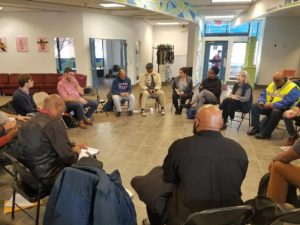
Mid-morning
A few hours of painting accomplished, eL Seed takes a break to join a circle of men gathered inside the Bank on Lancaster Avenue – a former drive-thru bank repurposed as social and cultural center — for the weekly Men’s Coffee Talk. Celebrating its second anniversary this sunny November morning, the Men’s Coffee Talk is the brainchild of People Emergency Center’s Kevin Brown, who realized the best way to improve the lives of the men he encounters daily on the streets of West Philadelphia, many without jobs, homes, or hope, was to create a safe space where men to share information, get resources and get support. Now, “the vibe,” says Brown, “is like the classic barber shop — where men from all walks of life congregate on equal footing.”
Today eL Seed joins the circle of men (and a few women) sitting on folding chairs, taking turns introducing themselves. There are representatives from People’s Emergency Center, Lutheran Settlement House, Drexel’s 11th Street Family Health Services, and other community activists and advocates. The atmosphere is relaxed and congenial. “When you do this community work, you have a kind of responsibility to connect,” Brown says, grinning. “Human hearts, they can connect fast. Each month we gather as men and leave as brothers.”
With eL Seed as the morning’s special guest, the conversation focuses on displacement. “When I think of displacement,” PEC’s ?? muses, “I also think of its opposite, which is placement.” He defines PEC’s role as a placemaker in the community. Their goal is “to expand the definition of home, to make it bigger and more inclusive.” Home can mean neighborhood. Home can be a place where people from different backgrounds and upbringings come together for shared purpose.
eL Seed talks of his own experiences with displacement, relating the story he had told Kinan and Nazem the day before about his own Parisian neighborhood, and the devastating impact of the closing of the Renault factory. The depressed economy, he said, laid the groundwork for later gentrification, an economic boom eL Seed’s family and neighbors couldn’t benefit from.
These men have other questions. “What is the racial climate like there?” “Have you gotten push back [for writing in Arabic?]”
What most people call racism, eL Seed says he calls ignorance. “Most of me is French,” he answers. “My face, I don’t look French.” He tells a story of “an old white French woman,” his family’s neighbor for 30 years. They lived peacefully side by side until a terrorist attack in Paris. Suddenly, she withdrew, grew suspicious and mean. “She no longer trusted us,” said eL Seed.
In his art and his life, he tries to bridge the divisions that fear and ignorance perpetuate. “I need to make people accept me for who I am. I’m French. I’m Arab. I’m a graffiti artist.”
And his Arabic “calligraffiti”, he believes, can become that bridge. One of the participants, scrolling through photographs of eL Seed’s projects on his phone, agrees. “In Arabic, you can say pretty much anything on that wall and it will look beautiful.”
***
Late afternoon
eL Seed is working fast. Just 24 hours after he started, the horizontal wall is outlined in black, with pink and magenta and blue being filled in. This afternoon he has help from Furness High School students, participants in Mural Arts after-school program. A few take turns riding up on the boom lift, spraying paint on the upper reaches of the horizontal wall. Others stand on the ground, filling in color or signing their names, in Roman alphabet, inside the thick outlines of the Arabic letters.
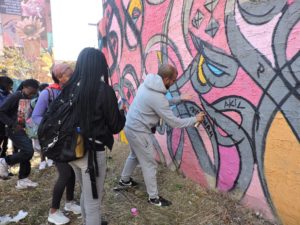
The students chatter to each other in several languages as they work, watch, and take selfies. They are all immigrants, all young women, coming from Honduras, China, Thailand. Many have arrived in Philadelphia just this year. Liya, a 20 year-old from China, declares the mural “cool.” She loves the many colors, she says, and the swirly shapes. “There are a lot of lines that aren’t straight.”
She shyly but proudly points to her own name on the wall. Her friends Shijia and Yazmin are there too. For eL Seed, including the names of participants and onlookers, along with those of his daughter and other family members far away, has become a tradition. In a few days, black paint will cover those names as the letters are filled in. Still, they are not erased, just hidden, secret testimony to the many hearts and hands and voices who joined in the making of the mural at Market and Preston Streets.
Day Five
Setbacks and Push-Backs | Wednesday, November 15, 2017
On Wednesday morning, eL Seed discovers that his cans of spray paint have been stolen. He stored them high up in the basket of the boom lift, presumably secure. But a group of men drove up in the middle of the night, scaled the arm of the lift, grabbed the paint, and drove off. A woman working the late shift at the rehab center across street witnessed the whole scene. She called the police immediately, but by the time anyone arrived, the thieves were long gone.
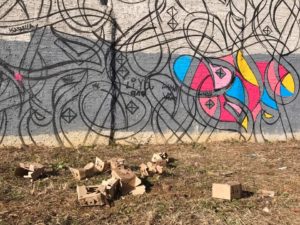
New paint has to be procured in Delaware. eL Seed has enough to work with, but the loss slows the morning’s progress.
***
Despite the setback, the walls quickly fill up with bright patches of pink and yellow and blue outlined in black. The swirling tracery of the letter forms has become less delicate, more assertive. Passers-by are drawn to the scene. The atmosphere at the worksite is festive. Strangers engage in conversation, curious about the mural and eL Seed’s work. Some observers already know eL Seed’s work and international reputation and come for the opportunity to witness a groundbreaking artist at work. Others, from seniors to school kids, are just passing by on their way to Rite Aid or school. They pause, enchanted by the spectacle of eL Seed in his grey sweats and hoodie working magic with cans of spray paint.
“He brought his love to us here.” says Elton Manson from South Philadelphia. “It’s beautiful what he’s doing.”
Elton and his good friend Jose Rodriguez from North Philly meet up regularly in West Philly to hang out together and “check out the scenery,” he says. “We like to have fun, laugh, joke around. As long as we’re together we have a good day.” This week they’ve both been watching the mural progress day by day. “We were here when there was no paint.” Now, says Elton, “It’s going to be eye catching because it’s right here on Market Street.”
Pam Andrews, who hosted Saturday’s community conversation, walks by on her way home to marvel at the progress. She especially loves the “bright, vibrant colors.” She knows there’s been some push back from the community. “There are still folks who say it doesn’t represent the Bottom.” She thinks it’s beautiful, though. “I love watching the look on people’s faces as they walk by.”
Days Six
Soul of The Black Bottom | Thursday, November 16, 2017
Thursday afternoon a 7th period art class walks over from Paul Robeson High School a block away on 42nd Street. The special admission (“magnet”) school focuses on social service and draw students interested in community engagement and social justice from all over the city.
eL Seed takes a break from painting to talk to the kids. He asks them about their artistic dreams and aspirations. Kris, a 17 year old senior, says he worries about making a living. His father isn’t too keen about his interest in art. “Follow your heart,” eL Seed encourages him. He says that being fired from his job in New York was the best thing that ever happened to him. “Don’t give up. Don’t listen to other people [who want to impose limitations],” he says to the circle of students pressing closer around him.

He tells them about his own upbringing, how his father didn’t know how to read or write. There were no books in their house, but his father noticed eL Seed’s brother struggling with his homework and brought home a French dictionary. Later, when eL Seed was about the age of these high school students, he reclaimed his Arab identity and learned to read and write his father’s language.
Two friends, 15 year old Shatika and 16 year old Alexis, both sophomores hover outside the circle, mesmerized by the mural. Shatika says she can’t wait until it’s finished. She’ll pass it twice a day on her way back and forth between the 40th Street El stop and her school.
Watching the colors deepen on the high brick wall as the sun slowly lowers behind her, Alexis has an insight. “In the morning, when the sun is rising it will hit this wall,” she points to the low horizontal wall. “In the afternoon, it will shine here,” she points up to where the sun is burnishing the bricks. She shares her observation with eL Seed. “I keep my head down when I walk to school,” she says. “I never used to look up. Now I will.”
***
Later that evening, the light has disappeared entirely. It’s 6:30 p.m. and eL Seed is still working in the cold and dark. When I stop by to see how he’s doing, he tells me that Kernard came by later in the day. After days of conversation, el Seed was persuaded to add some more words to the mural. On the right hand side of the horizontal wall where he had once thought he would paint a flat field of shiny silver, he is adding a single phrase to accompany Du Bois’ words:
“Soul of the Black Bottom.”
Day Seven
Heart and Soul | Friday, November 17, 2017
By Friday afternoon, as time grows short, more and more onlookers come. The atmosphere is still festive, but frantic too, with urgency and common purpose cementing the bonds that had been forming all week among the most frequent observers. Anyone willing is handed a paintbrush and put to work helping apply brick-colored paint to the wall’s surface. Afaq Mahmoud, one of the sisters from Sudan who told her story for the (dis)placed project, takes part, joining a pair of Penn students from France, Al Bustan staff and other volunteers. Kernard shows up wearing a black t-shirt with white letters that read: “The Black Bottom is not in University City. University City is in the Black Bottom. Don’t get it twisted.” He is thrilled with the new addition and promises that the next day more people from the Bottom will come to celebrate the mural’s completion.
There is still a lot to do on both walls.
The sun sets. Night falls. eL Seed and some of his most intrepid recruits paint until 10:30 so the mural will be ready for the next morning’s official unveiling.
Day Eight
The Unveiling | Saturday, November 18, 2017
“It’s delicious!” “Fabulous!” “Beautiful!” Words of enthusiasm ripple through the small crowd that gathers under thickening clouds on Saturday morning. Kernard is there in coat and tie, joined by a group of well-dressed men representing the Black Bottom. “Protectors of the neighborhood,” Kernard introduces them. Tara O’Brien and Tatelin El are there too, impressed by how much eL Seed accomplished in a week. Pam Andrews and her neighbors, Ardit Stuart Brown and Patricia Stuart Robinson, have come to celebrate the spectacular new addition to their neighborhood. This mural, says Richard Robinson’s, project director for (Dis)placed Philadelphia, speaks for “people in the past, living in the present, and looking to the future.”

Mural Art Philadelphia’s executive director Jane Golden praises Al-Bustan’s founder Hazami Sayed for her “incredible vision and tenacity…[and] the care that she takes to promote cross-cultural understanding among everyone.” Murals like eL Seed’s, she continues, are an antidote to displacement. “With gentrification happening at the speed of light,” she says, murals send a strong and positive signal to communities like West Powelton. “Murals says ‘you count, your life matters, you’re not going anywhere.” To reinforce this message, she announces that a Black Bottom mural is next on Mural Arts’ agenda.
“eL Seed has lit a fire,” she says. “His art connects us to our collective community and demonstrates art’s power to save our city, our country, and our planet.”
Patricia, standing in the audience, beams and nods at Jane Golden’s words. “Yes!” she says. “Yes!”
After Councilperson Jannie Blackwell speaks, Patricia joins her sister Ardit and her husband Warren at the microphone, as Pam speaks for all the neighbors. She talks of “the pride of place that unites the Black Bottom and the 40th Street corridor.” eL Seed’s mural shows us as “a vibrant community capable of transformation.”
Then Kernard speaks about the proud history of the Black Bottom. “We are displaced but not discouraged,” he says. “We have moved but our spirits remain.”
eL Seed speaks last. He eyes the sky. Light rain has started to fall. He still has work left to do. He celebrates the community he has come to know over the course of an intense week. “It was a really, really interesting, amazing journey,” he tells those gathered. He was impressed by the “sense of belonging and ownership to place.”
And as Jane Golden said, eL Seed has lit a fire. The mural will catalyze other improvements along Market Street and the 40th Street corridor. Pam Andrews, on one of her strolls by the site, realized that the vacant strip of patchy grass could benefit from some benches. Residents of University Square Apartments walking to Rite Aid could sit and rest beside the colorful walls.
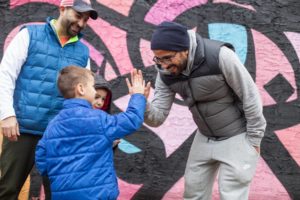
In a week’s time, a leftover space, an untended lot and a rough, blank wall are transformed into a place that draws people, that sparks delight and generates conversation. And that place can become even more — a way-station, a landmark, a place that matters.
Day Nine
Triumph | Sunday, November 19, 2017
eL Seed still has touch up work to do on Sunday morning, before he catches an afternoon train to New York. He finishes just after noon. There is one last thing he wants to do before he leaves Philly.
Hazami drives him to the Art Museum. He runs up the famous steps and when he reaches the top he raises his arms Rocky-style.
His week in Philadelphia has been a triumph.


